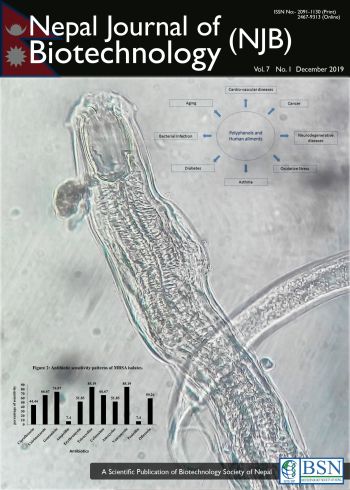Screening of Methicillin Resistant Staphylococcus aureus (MRSA) from Wounds in Pediatric Patients Visiting Tertiary Care in Hospital
DOI:
https://doi.org/10.3126/njb.v7i1.26957Keywords:
Staphylococcus aureus, MRSA, Antibiotic sysceptibiity test, Disc-diffusion, Methicillin resistantAbstract
The extent of methicillin-resistant Staphylococcus aureus (MRSA) in children is still unknown. The collected wound pus samples were processed. Identification of S. aureus was done according to standard microbiological procedures as per the clinical laboratory standards institute (CLSI) guidelines (2016). The antibiogram of the isolates was carried out by the Kirby-Bauer disc diffusion technique. MRSA was determined by measuring the zone of inhibition (ZOI) surrounding to cefoxitin disc, with resistance defined as ZOI of ≤ 21 mm. Out of 357 bacterial culture-positive samples, 278 (77.87 %) were S. aureus isolates, among them 102 (36.69%) were found to be MRSA. The percentage of MRSA isolates was found high in male children and inpatients with 61.76 % and 73.52% respectively. All the MRSA isolates were susceptible to gentamicin (79.41%), whereas (91.17%) were resistant to penicillin. The distribution of MRSA in inpatients 75 (73.52%) is higher than that of outpatients 27 (26.74%). This study shows that the MRSA occurrence is prevalent in pediatric patients.
Downloads
Downloads
Published
How to Cite
Issue
Section
License
Copyright Notice:
The manuscript submitted to NJB must be an original contribution, not previously published and should not be under consideration for publication elsewhere. When the manuscript is accepted for publication, the authors agree to automatically transfer the copyright of the article to the publisher. It should grant permission to any third party, in advance and in perpetuity, the right to use, reproduce or disseminate your article, according to the NJB copyright and license agreement.
Authors transfer copyright to the publisher as part of a journal publishing agreement but have the rights to: Share their article for Personal Use, Internal Institutional Use and Scholarly Sharing purposes, with the NJB applies the Creative Commons Attribution-NonCommercial CC BY-NC license to all the works we publish after Jun 2020 (Before it was CC BY-NC-ND). Under this license, authors agree to make articles legally available for reuse, without permission or fees, for virtually any non-commercial purpose. Anyone may remix, adapt, and build upon your work non-commercially, and although their new works must also acknowledge you and be non-commercial, they don’t have to license their derivative works on the same terms. More details on CC BY-NC refer to its Licence Deed and Legal Code.






